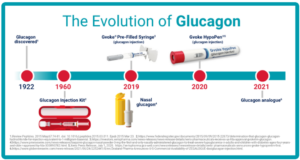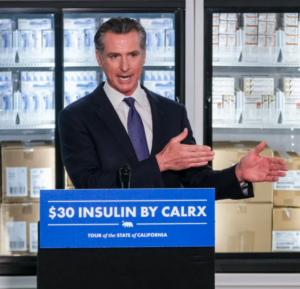LOTS to READ in this week’s issue of The Savvy Diabetic:
-
Glucagon Prescriptions are UP … BUT Fall Short of Meeting Demand
-
Special Gut Bacterium Could Help Cut Sugar Cravings
-
FDA bans controversial red dye
-
Processed Red Meat Increases Dementia Risk
-
Empathy-Focused Calls Boost Diabetes Self-Care
-
FTC Releases 2nd Report Slamming PMBs
-
BG Levels Spike More from Pasta/Pizza in America than in Italy
-
Newsom Committed California to Making Insulin … It is Delayed
-
Ozempic Picked by Medicare for Price Talks
-
Loop and Learn with Adam Brown, T1D, Author, Juggler (video)
-
Trial for New Treatment for T1D and Chronic Kidney Disease,
-
Omnipod’s Next-Gen Pump with Justin Eastzer’s Diabetech (video)
Glucagon Prescriptions Still Fall Short of Meeting Demand by Vindo Rane for MedScape.com, 15 January 2025.
 Glucagon prescriptions for severe hypoglycemia in Medicaid initially decreased from 2012 to 2018 but increased between 2019 and 2023 following the introduction of newer products.
Glucagon prescriptions for severe hypoglycemia in Medicaid initially decreased from 2012 to 2018 but increased between 2019 and 2023 following the introduction of newer products.
Glucagon prescriptions decreased by 28% from 78,505 in 2012 to 56,722 in 2018; however, they increased by 61% from 56,838 in 2019 to 91,732 in 2023 following the introduction of newer glucagon products. Between 2019 and 2023, prescriptions for nasal spray formulations increased from 4% to 48%, those for glucagon autoinjectors increased by 18%, and those for unmixed syringes dipped from 96% to 31%; prefilled syringes and dasiglucagon autoinjectors constituted < 3% of annual glucagon prescriptions each year.
“Less than 100,000 glucagon prescriptions were dispensed in 2023. The appropriate number of glucagon prescriptions is unknown, but the observed number is likely a fraction of the potential need based on the high-risk population,” the authors wrote.
Read more: Glucagon Prescriptions Still Fall Short of Meeting Demand
Special gut bacterium could help cut sugar cravings was reported by Tingting Zhang and published by MedicalXpress.com, 13 January 2025.
 Researchers have identified a gut bacterium that may be associated with reduced dietary sugar intake. The findings, which are based on analyses of humans and mice, could aid the development of therapies to manage obesity and metabolic diseases, such as type 2 diabetes. The study is published in the journal Nature Microbiology.
Researchers have identified a gut bacterium that may be associated with reduced dietary sugar intake. The findings, which are based on analyses of humans and mice, could aid the development of therapies to manage obesity and metabolic diseases, such as type 2 diabetes. The study is published in the journal Nature Microbiology.
Animals are biologically hardwired to crave sugars, but unmanaged sugar preference can lead to high sugar intake, resulting in high blood glucose and an increased risk of metabolic diseases. Previous research suggests that our cravings for different foods originate from signals sent to the brain from the gut, a key organ in transmitting dietary preferences. However, the regulation of sugar cravings is a complex process, and the role of gut microbes is unclear.
In mouse models, Zhu and colleagues found that pantothenate was responsible for the secretion of GLP-1 and subsequent secretion of FGF21, a liver hormone that acts directly on the hypothalamus, which is the brain region that controls feeding behavior. They verified this complex gut–liver–brain connection by feeding diabetic mice pantothenate or colonizing them with B. vulgatus, which were both found to significantly decrease their sugar-seeking behavior. Further clinical research is needed to investigate this gut–liver–brain axis as a target for therapies that may help manage metabolic diseases, the authors note.
Read more: Special gut bacterium could help cut sugar cravings
FDA bans controversial red dye found in candy, drinks and snacks by Rachel Roubein for WashingtonPost.com, 15 January 2025.
 Federal officials moved to ban a controversial bright red dye used in drinks and snacks linked to cancer in animals, a decision arriving decades after the coloring was removed from cosmetics. The Food and Drug Administration’s action affects red dye No. 3, which was approved for permanent use in food and ingested drugs more than 50 years ago. The decision comes more than two years after advocates pressured the agency to ban the dye, which is used in bubblegum, candy, and fruit cocktail, arguing that it is safer to use natural coloring derived from plants such as beets and red cabbage.
Federal officials moved to ban a controversial bright red dye used in drinks and snacks linked to cancer in animals, a decision arriving decades after the coloring was removed from cosmetics. The Food and Drug Administration’s action affects red dye No. 3, which was approved for permanent use in food and ingested drugs more than 50 years ago. The decision comes more than two years after advocates pressured the agency to ban the dye, which is used in bubblegum, candy, and fruit cocktail, arguing that it is safer to use natural coloring derived from plants such as beets and red cabbage.
Studies have shown that high doses could cause cancer in rats, prompting the FDA to decide to remove the artificial dye. But the agency maintains that there is no evidence that ingesting the cherry-red coloring causes cancer in humans.
Red dye No. 3 must be removed from food by mid-January 2027 and excised from ingested drugs the following year. The FDA said its decision to ban red dye No. 3 was based on a federal law called the Delaney Clause, which prohibits additives found to cause cancer in humans or animals at any dose.
How does that impact those of us in the diabetes community? Think Skittles and other fast glucose candies.
Read more: FDA bans controversial red dye found in candy, drinks and snacks
Can eating more processed red meat increase your dementia risk? by Corrie Pelc for MedicalNewsToday.com, 15 January 2025.
 Past studies show that eating processed meats — such as hot dogs, sausages, salami, and bacon — can increase a person’s risk for several health issues, including type 2 diabetes, heart disease, and cancers such as colorectal cancer, breast cancer, and prostate cancer. Previous research has also shown a potential correlation between consuming processed meats and a heightened risk for neurological conditions such as dementia and cognitive decline.
Past studies show that eating processed meats — such as hot dogs, sausages, salami, and bacon — can increase a person’s risk for several health issues, including type 2 diabetes, heart disease, and cancers such as colorectal cancer, breast cancer, and prostate cancer. Previous research has also shown a potential correlation between consuming processed meats and a heightened risk for neurological conditions such as dementia and cognitive decline.
Now, scientists at Brigham and Women’s Hospital in Boston add to this body of research with a new study that found people who eat more processed red meat have a greater risk of developing cognitive decline and dementia than those who eat very little red meat.
“It is important for researchers to continue exploring how what we eat impacts brain health because diet is a modifiable risk factor that offers significant potential for dementia prevention and cognitive health improvement,” Yuhan Li, MS, research assistant at Channing Division of Network Medicine in the Department of Medicine at Brigham and Women’s Hospital and the first author of this study told Medical News Today.
“With the growing global burden of dementia and the lack of a cure, understanding the relationship between diet and brain health can help develop evidence-based dietary guidelines,” he said. Researchers also found that replacing one daily serving of processed meat with a serving of nuts, legumes, fish, or chicken helped lower the risk of dementia. The study was recently published in Neurology, the medical journal of the American Academy of Neurology.
Empathy-Focused Calls Boost Diabetes Self-Care by Manasi Talwadekar for MedScape.com, 9 January 2025.
 Empathetic telephone calls by laypeople may improve glycemic control in patients with uncontrolled diabetes and low income, particularly in those with subclinical depressive symptoms.
Empathetic telephone calls by laypeople may improve glycemic control in patients with uncontrolled diabetes and low income, particularly in those with subclinical depressive symptoms.
Managing diabetes is especially challenging for low-income patients, in part due to associated emotional distress and mental health decline, but limited healthcare touchpoints exist to support the necessary lifestyle changes to improve disease management.
“Our exploratory results support the importance of addressing patients’ diabetes-related emotional distress to effectively improve glycemic control,” the authors wrote. “[The trial] raises the intriguing possibility that the critical ingredient for many people with diabetes who want to improve glycemic control could be social support,” wrote experts in an invited commentary.
Read more: Empathy-Focused Calls Boost Diabetes Self-Care
FTC releases second report slamming pharmacy benefit managers by Rebecca Pifer for HealthCareDive.com, 15 January 2025.
 The Federal Trade Commission has released its second report digging into how the business practices of pharmacy benefit managers could be inflating drug costs in the U.S., in the latest and likely last salvo between antitrust regulators in the Biden administration and the controversial middlemen in the drug supply chain.
The Federal Trade Commission has released its second report digging into how the business practices of pharmacy benefit managers could be inflating drug costs in the U.S., in the latest and likely last salvo between antitrust regulators in the Biden administration and the controversial middlemen in the drug supply chain.
The report accuses CVS’ Caremark, Cigna’s Express Scripts and UnitedHealth’s Optum Rx of jacking up the price of lifesaving drugs by hundreds and thousands of percent. The so-called “Big Three” PBMs also directed the most profitable prescriptions to affiliated pharmacies at the expense of independent operators, and paid themselves more than other pharmacies for dispensing drugs, the report says.
The findings are similar to those in the FTC’s initial report released last summer as part of the agency’s ongoing investigation into PBMs. However, the second report looks at a much broader array of drugs after the first report was criticized for relying on too little data. FTC commissioners voted unanimously to release the report on Tuesday.
Read more:
Blood sugar levels spike more from pasta and pizza in America than in Italy by Emily Joshu Sterne & Conor Seery for Diabetes.co.uk, 13 January 2025.
 Eating pasta and pizza in Italy is better for your blood sugar levels than consuming them in America, a health reporter has demonstrated.
Eating pasta and pizza in Italy is better for your blood sugar levels than consuming them in America, a health reporter has demonstrated.
Read more: Blood sugar levels spike more from pasta and pizza in America than in Italy
Newsom committed California to making its own insulin. It’s at least a year behind his schedule by Kristen Hwang for CalMatters.org, 15 January 2025.
 Gov. Gavin Newsom’s ambitious plan to produce cheap, generic insulin for the 3.2 million Californians with diabetes is behind the schedule he announced and unlikely to make it to market for several years, industry experts say. Civica, Inc., the nonprofit drug manufacturer contracted to produce insulin for California, has not started clinical trials or applied for approval from the federal Food and Drug Administration, both of which are likely to take more than a year to complete.
Gov. Gavin Newsom’s ambitious plan to produce cheap, generic insulin for the 3.2 million Californians with diabetes is behind the schedule he announced and unlikely to make it to market for several years, industry experts say. Civica, Inc., the nonprofit drug manufacturer contracted to produce insulin for California, has not started clinical trials or applied for approval from the federal Food and Drug Administration, both of which are likely to take more than a year to complete.
During his 2023 State of the State tour, Newsom announced California would begin selling insulin for $30 a vial with a “2024 delivery in terms of timeline,” pending FDA approval. That target has come and gone. A 2020 law aimed partially at bringing down insulin prices allowed Newsom to negotiate the 10-year, $50 million contract with Civica. Newsom earmarked an additional $50 million to seed the construction of a drug manufacturing facility in California.
In the meantime, insulin prices have dropped nationally as a result of public pressure, the Biden administration’s 2023 cap on insulin prices for some seniors with Medicare, and changes to Medicaid rules that tied drug prices to inflation. At least 25 states and the District of Columbia have also implemented monthly co-pay caps to help offset continuing expenses for diabetics.
California is not one of those states. Newsom rejected a $35 monthly insulin copay cap. In his veto message, he cited the state’s $100 million investment in insulin production as an example of his administration’s efforts to reduce costs without a price cap.
The state’s effort to manufacture insulin is “getting at the underlying cost, which is the true sustainable solution to high-cost pharmaceuticals. With copay caps, however, the long-term costs are still passed down to consumers through higher premiums from health plans,” Newsom wrote in his veto message.
Read more: Newsom committed California to making its own insulin. It’s at least a year behind his schedule
Ozempic, Ibrance among next drugs picked by Medicare for price talks by Ned Pagliarulo for BioPharmaDive.com, 17 January 2025.
 Semaglutide, the popular drug sold by Novo Nordisk as Ozempic for diabetes and Wegovy for weight loss, is among a group of widely used medicines selected by the U.S. government for the next round of price negotiations under a 2022 law aimed at curtailing pharmaceutical costs within Medicare.
Semaglutide, the popular drug sold by Novo Nordisk as Ozempic for diabetes and Wegovy for weight loss, is among a group of widely used medicines selected by the U.S. government for the next round of price negotiations under a 2022 law aimed at curtailing pharmaceutical costs within Medicare.
Publication of the list kicks off a monthslong process that will feature a series of meetings between drugmakers and the Centers for Medicare and Medicaid Services, which oversees the Medicare insurance program. The negotiations, which drugmakers have opposed vociferously, will yield “maximum fair prices” that take effect in 2027.
Read more: Ozempic among next drugs picked by Medicare for price talks
Loop and Learn with Adam Brown, T1D, Author, Juggler, 16 January 2025, shared on YouTube Loop and Learn channel.
 Adam Brown, therapist, advocate, diabetes tech expert and juggler, on mental health, discusses a key part of managing T1D, not something extra. He is the author of the best-selling Bright Spots & Landmines (https://diatribe.org/bright-spots-and-landmines/). He previously contributed to diabetes publications: Close Concerns and http://diaTribe.org.
Adam Brown, therapist, advocate, diabetes tech expert and juggler, on mental health, discusses a key part of managing T1D, not something extra. He is the author of the best-selling Bright Spots & Landmines (https://diatribe.org/bright-spots-and-landmines/). He previously contributed to diabetes publications: Close Concerns and http://diaTribe.org.
Adam is now a therapist in private practice in San Francisco (http://www.adambrowntherapy.com), supporting people with diabetes and other difficult life experiences.
Join Trial Studying New Treatment for Type 1 Diabetes and Chronic Kidney Disease, by Anna Vidovszky for diaTribe.org, 13 January 2025
 A trial is recruiting adults with type 1 diabetes and chronic kidney disease to investigate the drug sotagliflozin for protecting kidney function. Despite concerns about diabetic ketoacidosis (DKA), previous research suggests that a DKA prevention plan can minimize risks.
A trial is recruiting adults with type 1 diabetes and chronic kidney disease to investigate the drug sotagliflozin for protecting kidney function. Despite concerns about diabetic ketoacidosis (DKA), previous research suggests that a DKA prevention plan can minimize risks.
Sotagliflozin is an SGLT-2 inhibitor approved to treat type 2 diabetes, heart failure, and chronic kidney disease. Specifically, the medication has been shown to prevent or delay end-stage kidney disease in people with type 2 diabetes. However, it’s unclear if these drugs work the same way and are safe for people with type 1 diabetes. Studies that have been done on SGLT-2 medications in people with type 1 diabetes have shown an increased risk of diabetic ketoacidosis.
However, one study showed that although still elevated compared to placebo, a DKA prevention plan could help reduce this risk. The current trial will test whether a similar prevention plan can help improve kidney health in people with type 1 diabetes and moderate to advanced chronic kidney disease over three years. If successful, the trial will provide data that might be used to seek FDA and Health Canada approval of sotagliflozin for people with type 1 diabetes and kidney disease.
Click HERE for Participation Criteria
Read more: Join Trial Studying New Treatment for Type 1 Diabetes and Chronic Kidney Disease
Omnipod’s Next-Gen Pump: Top 5 Upgrades I Want by Justin Eastzer for Diabetech.com, 7 January 2025.
 Omnipod has been the leader in tubeless insulin pumps for over a decade. From the Eros to the DASH, and now the Omnipod 5 hybrid-closed loop system, it’s clear Omnipod has its foothold in the market. But more tubeless competition is on the horizon, with companies like Tandem and Medtronic working on their own tubeless pumps. A new version of Omnipod, perhaps Omnipod 6, is undoubtedly in the works to get ahead. According to Justin Eastzer, “I’m diving into all the features I want to see Omnipod implement on future hardware and software to make its system truly feel next-level.”
Omnipod has been the leader in tubeless insulin pumps for over a decade. From the Eros to the DASH, and now the Omnipod 5 hybrid-closed loop system, it’s clear Omnipod has its foothold in the market. But more tubeless competition is on the horizon, with companies like Tandem and Medtronic working on their own tubeless pumps. A new version of Omnipod, perhaps Omnipod 6, is undoubtedly in the works to get ahead. According to Justin Eastzer, “I’m diving into all the features I want to see Omnipod implement on future hardware and software to make its system truly feel next-level.”
-
-
- An improvement I’d love to see is the capability for users to step away from their mobile device freely with the addition of a bolus button directly on the pod.
- I’d like to see a pod that holds up to 300-units of insulin.
- I’d love to see a fully closed-loop system—where the pump makes all the decisions, from adjusting insulin delivery for meals to exercise, without needing to log anything manually or worry where my glucose levels are headed. Omnipod is already working on its Evolution Algorithm, which could help push the system closer to a fully closed loop. Initial trials have shown promising time-in-range (TIR) results without the need for manual boluses, especially for users with type 2 diabetes.
- CGM compatibility: I want to see Libre 3 Plus compatibility. It’s smaller, more accurate, and would be a great fit for Omnipod. Another major upgrade would be support for the Eversense 365 implantable CGM.
- it’d I would love to be able to control my Omnipod via a smartwatch. be awesome to see Android app improvements and better integration with smartwatches.
-

